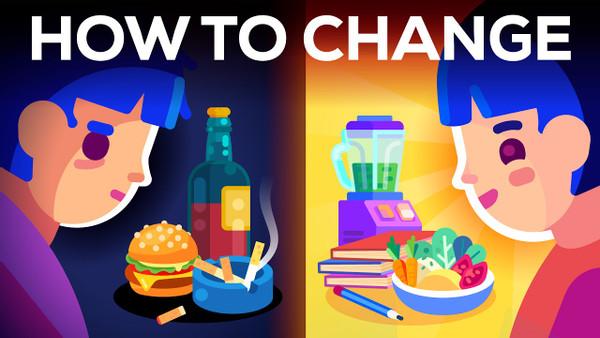Change Your Life – One Tiny Step at a Time
Curated from: Kurzgesagt – In a Nutshell
Ideas, facts & insights covering these topics:
9 ideas
·645 reads
11
Explore the World's Best Ideas
Join today and uncover 100+ curated journeys from 50+ topics. Unlock access to our mobile app with extensive features.
🔥 INTRODUCTION
If you’re frustrated because you’re not where you want to be, chill – that’s just part of the journey. We all have that gap between who we are and who we want to become. Every action, no matter how small, can get you closer to being that person. Forget perfection, let’s focus on tiny steps that actually change things.
27
114 reads
🌱 1. Routines vs. Habits
Definition:
Routines are planned actions you consciously decide to do, like brushing your teeth.
Habits are actions that feel automatic because you’ve done them so often – like reaching for your phone.
Example:
"I have a routine of setting my alarm for 6:30 AM every night. But reaching for my phone as soon as I wake up? That’s a habit."
Application:
Start with a routine to make a change. For instance, if you want to study in the morning, create a morning routine where your notebook is always on your desk by 7 AM. Repeat it daily – it’ll eventually feel like a habit.
28
91 reads
🚀 2. Using Triggers to Build Habits
Definition:
A trigger is something that reminds your brain to start an action, like seeing your gym bag near the door = time to work out.
Example:
"I keep my sneakers by my bed, so every morning, I’m reminded to go for a jog before doing anything else."
Application:
Want to study more? Try leaving your notes on your desk each night. Seeing them as soon as you wake up becomes your “trigger” to dive right into studying.
27
81 reads
⚡️3. Turning Small Actions into Big Gains
Definition:
Start with small, manageable tasks. These “micro-actions” build momentum and make real change less intimidating.
Example:
"I want to get fit, so instead of committing to an hour workout every day, I start with 10 push-ups. Easy to fit in, no excuses."
Application:
Identify one tiny action for each goal. Want to write? Start with 5 sentences a day. It’s simple, and you’re building consistency without feeling overwhelmed.
30
75 reads
🔄 4. Making Habits Stick Through Rewards
Definition:
Rewarding yourself for doing a habit makes your brain want to repeat it. The reward can be small, like a quick break or snack.
Example:
"I treat myself to a coffee only after I’ve studied for an hour. It’s a reward that makes studying feel worth it."
Application:
Find a reward that motivates you. If you study for 30 minutes, reward yourself with a song you love or a short chat with a friend.
27
65 reads
🧠 5. Get the “Wise Planner” and “Impulsive Toddler” to Work Together
Definition:
Your brain has a “Wise Planner” for long-term goals and an “Impulsive Toddler” for instant gratification. They need balance.
Example:
"My Wise Planner sets a goal to study 2 hours a day, but my Toddler always gets distracted. I use a timer to keep them focused."
Application:
Let the Wise Planner choose study goals, but allow the Toddler to take breaks. Try studying for 25 minutes, then give yourself a 5-minute break. They’ll both stay happy.
26
61 reads
🔥 LET'S TRY IT!
Problem: You want to study every day after school, but every time you try, you end up distracted by your phone or chatting with friends. You never seem to get into the habit, and it feels like a constant struggle.
26
57 reads
Solution: Step-by-Step Guide
- Set a Trigger: Leave your study materials on your desk right before you leave for school. When you get back, they’ll remind you it’s time to study.
- Micro-Action: Don’t commit to studying for hours right away. Start with 10 minutes, just to get into the flow.
26
51 reads
Solution: Step-by-Step Guide
3. Add a Reward: Once you’ve completed the 10 minutes, reward yourself with a few minutes on your phone or a quick snack.
4. Repeat and Build: After a week, increase your study time by 5 minutes. Keep the reward but gradually increase the work.
5. Stay Consistent: After a month, studying after school will feel natural, and you won’t need to rely as heavily on the reward or the trigger.
28
50 reads
IDEAS CURATED BY
CURATOR'S NOTE
Your brain is like a jungle: everything you do leaves a path. The more you repeat something, the more it becomes your brain’s “go-to” route. That’s why you feel “stuck” in routines or habits. But here’s the thing: by understanding how your brain works, you can trick it into building new paths, helping you get closer to your goals with a lot less effort than you’d expect.
“
Similar ideas
7 ideas
Is Organic Really Better? Healthy Food or Trendy Scam?
Kurzgesagt – In a Nutshell
5 ideas
We Need to Rethink Exercise (Updated Version)
Kurzgesagt – In a Nutshell
10 ideas
The Cosmic Journey: Unraveling the Mystery of Existence
Kurzgesagt – In a Nutshell
Read & Learn
20x Faster
without
deepstash
with
deepstash
with
deepstash
Personalized microlearning
—
100+ Learning Journeys
—
Access to 200,000+ ideas
—
Access to the mobile app
—
Unlimited idea saving
—
—
Unlimited history
—
—
Unlimited listening to ideas
—
—
Downloading & offline access
—
—
Supercharge your mind with one idea per day
Enter your email and spend 1 minute every day to learn something new.
I agree to receive email updates
